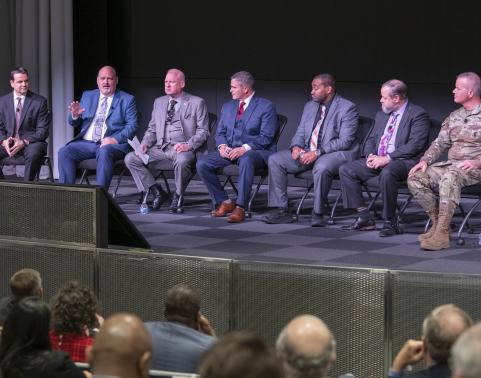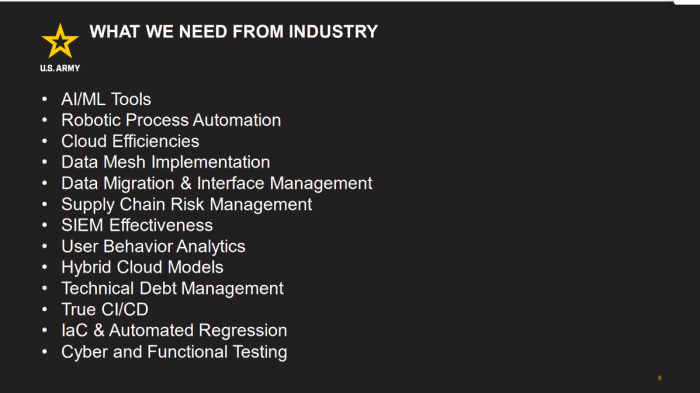PEO EIS holds first-of-its-kind “Forecast to Industry”

Program Executive Office Enterprise Information Systems (PEO EIS) held a “Forecast to Industry” — the first event of its kind — Nov. 30 at the Defense Acquisition University’s Howell Auditorium at Fort Belvoir, Virginia. The event, simultaneously livestreamed on LinkedIn and YouTube, enabled industry attendees to learn about EIS’ ongoing Agile journey and upcoming procurements, and to pose related questions.
Kicking off the event, EIS Program Executive Officer Ross Guckert walked attendees through EIS’ recent organizational and leadership changes, noting that the acquisition organization still remains “a very large portfolio … to me the most complex in the Army, supporting just about every Soldier and civilian.”
Based on EIS’ new Agile approach and go-forward focus on defense business systems, enterprise resource planning (ERP) systems and enterprise services, Guckert introduced new vision and mission statements for the organization:
VISION
Be the Army’s trusted, leading provider of continuously and rapidly delivered digital enterprise solutions and services.
MISSION
Deliver software and services for Soldiers and Civilians at speed to transform and modernize the Army.
As EIS delivers on its mission, it will continue relying heavily on its partnership with industry — the PEO received a record 864 meeting requests in fiscal year 2023. About half of the companies supporting EIS are small businesses, and around 32% of EIS’ spend goes to them, said Guckert, noting he’d still like to increase activity with HUBZones and women-owned small businesses.
“At the end of the day, I really recognize that the innovation and the best practices come from industry, come from the small businesses, come from the start-ups,” said Guckert, “and so we don’t put anything final on the street until we hear from you.”
Having fully embraced Agile methodologies and moved away from the concept of sustainment, EIS is in “continuous modernization mode,” said Guckert, and is looking to industry to provide tools and services in many areas, including data mesh implementation, true continuous integration/continuous delivery (CI/CD) and cyber and functional testing, among others.
Following Guckert’s remarks, EIS Deputy PEO Bill Hepworth detailed how the organization is working to reduce delivery timelines and ensure capabilities meet Soldiers’ and civilians’ needs. This includes bringing end users into the development process and reducing acquisition timelines.
“Two-year start-ups are out the window,” said Hepworth. “We’re going to be shooting for six months … by using a whole lot of the Software Acquisition Pathway.”
With the help of EIS Assistant PEO Rob Schadey and Chief Information Officer Mike Chappell, EIS will be on the forefront of innovation, according to Hepworth, citing ArmyIgnitED, Army Contract Writing System and Integrated Personnel and Pay System – Army (IPPS-A) as examples.
“EBS-C [Enterprise Business Systems – Convergence] is going to be one of the most unrecognizable ERP implementations you’ve ever seen,” said Hepworth. “They’re already poised for success using Agile methodology.”
When it comes to flexibility, Hepworth has been impressed at how organizations are using existing Army software programs like Army Vantage and IPPS-A to collaborate.
“Lately, I love sitting in different program reviews, and everybody’s talking about using Army Vantage,” he said. “How cool is that? Just voluntarily deciding to use an existing Army asset rather than go build something new. We’re seeing more and more of that cross-collaboration.”
Hepworth concluded his remarks by debuting EIS’ new FY24-26 Digital Modernization Strategy, which will serve as an operational model for the organization for years to come.
During the remaining two hours of EIS’ Forecast to Industry, leaders from each of the organization’s five project management offices spoke about challenges and opportunities within their portfolios. The following are some highlights from their presentations:
Army Data and Analytics Platforms (ARDAP)/Project Manager Brian Raftery
- The Army Data Platform (ADP) request for information (RFI) was released on Nov. 30 with responses due Jan. 19, 2024.
- Top three business opportunities include ARDAP’s Systems Engineering and Technical Assistance contract; Global Force Information Management’s Federal Acquisition Regulation-based contract; and multiple opportunities to support ADP 2.0.
- ARDAP is looking for modular solutions that aren’t tightly coupled with any one technology/solution; able to integrate with existing CI/CD pipelines; and open architectures with limited proprietary or intellectual property (IP) restrictions.
Based on feedback and questions following last week’s event, Raftery offered additional context regarding his remarks on data ownership.
“To clarify my remarks last week, our concern about data ownership/rights is directed at the entire defense technology community regarding the Army’s expectations of industry and will inform future data requirements across several programs,” he said.
“To be clear, we’re satisfied with the Army Vantage program, its IP contract language, its open data environment to facilitate Army collaboration and its connection with third- party tools. We are looking forward to reviewing the RFI responses to improve the approach for ADP 2.0,” he added.
EBS-C/Deputy Project Manager Michael Gormley
- An Other Transaction Authority (OTA) is currently underway with three vendors in the cARMY environment.
- Top opportunity is the Technical Management and Advisory Support Services follow-on contract.
- In summer 2024, Lt. Col. Melvin Mitchell will assume the charter as project manager for EBS-C.
- “We’re looking for agility and innovation in all you do,” said Gormley.
Enterprise Services (ES)/Project Director Reg Shuford
- Top business opportunities include Computer Hardware, Enterprise Software and Solutions (CHESS)’ ITES-4S and ITES-4H contracts. There will be a CHESS Industry Day for 4S in February.
- Other business opportunities will come from Enterprise Computing (EC) and from Acquisition, Logistics and Technology Enterprise Systems and Services (ALTESS) for hybrid cloud services.
- Capabilities needed include procurement initiatives/modernization; flexible development, integrator and engineering services; and commercial off-the-shelf (COTS) marketplace purchasing tools.
- “We want to make COTS tools available via Enterprise License Agreements and automate that too,” said Shuford.
Defense Integrated Business Systems (DIBS)/Project Manager Kevin Curry
- Top three business opportunities include leveraging generative artificial intelligence for the enterprise; embedding analytics and collaboration; and improving shop floor user experience.
- Capabilities needed include rapid delivery, solution scalability and audit logging.
- “CI/CD is of top importance,” said Curry.
IPPS-A/Project Manager Col. RJ Mikesh
- Top three business opportunities include Army Military Pay, Cloud Migration and Operational Medical Information System – Army Engineering and Technical Support.
- Capabilities needed include Oracle PeopleSoft expertise, cloud/migration hosting, CI/CD and automated testing, skilled Agile software development and engagement layer technologies.
- “I need to move [IPPS-A] to the cloud; I want to start that in FY24,” said Mikesh.
The slide deck from the Forecast to Industry event is available on PEO EIS’ website.
Related News
-
Onedia James: a logistician and leader with a family legacy of service
April 22, 2025Onedia James recently stepped into the role of acting deputy project manager for Army Data and Analytics Platforms (ARDAP) at U.S. Army Program Executive Office (PEO) Enterprise, where she helps oversee and support the data portfolio’s four programs. -
PEO Enterprise’s new PL Digital Market reimagines IT product/service procurement
April 2, 2025FORT BELVOIR, Va. – U.S. Army Program Executive Office (PEO) Enterprise today announced the launch of the Product Lead (PL) Digital Market, which replaces PL Computer Hardware, Enterprise Software and Services (CHESS), effective Apr. 2, 2025. -
Two vastly different Army programs prepare for Software Acquisition Pathway
March 24, 2025At U.S. Army Program Executive Office Enterprise, which is now over two years into its Agile transformation, several enterprise software programs are already in the execution phase of the DOD’s Software Acquisition Pathway, which is designed to facilitate rapid and iterative delivery of software capability to users.
Work for Us
Join a winning team! Search for job opportunities with PEO Enterprise.
Work with Us
Help support important missions. Explore ways your company can work with PEO Enterprise.
